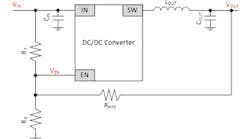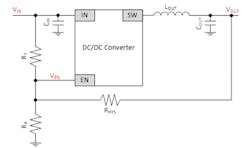Added Hysteresis Enhances DC-DC Converter Performance (.PDF Download)
Today’s dc-dc converters use an enable pin to control the design conditions at which the power supply turns on and off. However, your dc-dc converter may not have this “enable hysteresis” control, or the internal hysteresis value may be too small. It is possible to add an adjustable hysteresis to your dc-dc converter’s enable signal, though. You can replicate this technique by using Excel spreadsheet calculations, Texas Instruments (TI) TINA-TI software simulations, and evaluation-module (EVM) testing.
It’s standard electrical engineering practice to add feedback around a comparator using a hysteresis resistor (adding feedback). You can apply this same idea to a dc-dc converter by adding a resistor connecting the enable signal to the output voltage. By adding the output voltage to the enable signal, the enable signal will be pulled even higher once the converter produces an output (Fig. 1).
1. Hysteresis can be added to a dc-dc converter by adding a resistor connecting the enable signal to the output voltage.

